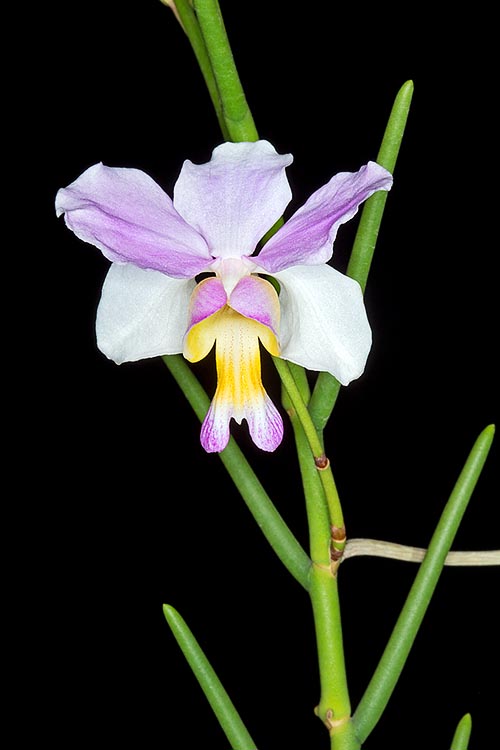Family : Orchidaceae

Text © Pietro Puccio

English translation by Mario Beltramini

Papilionanthe teres is an epiphyte with even 2 m long stems of South-East Asia. The splendid, long-lasting and perfumed flowers are of 6-10 cm of diameter © G. Mazza
The name of the genus is the combination of the Latin substantive “Papilio, onis” = butterfly and of the Greek “ἄνθος” (anthos) = flower, with obvious reference; the name of the species is the Latin adjective “teres” = round, with reference to the cylindrical stems and leaves.
Common names: terete vanda (English); euang mok, euang thiene (Lao); ueang mok kulap, ueang kean (Thai); lan cành giao (Vietnamese).
The Papilionanthe teres (Roxb.) Schltr. (1915) is an epiphytic species with up to about 2 m long, cylindrical, ramified stems, provided of several aerial roots and more or less erect leaves, alternate, distichous, fleshy, cylindrical, 8-20 cm long and of 0,4-0,5 cm of diameter. Lateral racemose inflorescences opposite to the leaf, 15-30 cm long, bearing 2-6 flowers of 6-10 cm of diameter with ovate-elliptic sepals having rounded apex, up to about 3,5 cm long and 2-3 cm broad, with waved margins, of white or white suffused of pink or purple colour, almost orbicular petals with undulated margins, twisted at the base, 3-4 cm long and 2,8-3 cm broad, of the same colour as the sepals, trilobed labellum, 3,8 cm long and 3,2 cm broad, pubescent, with semi-circular lateral lobes erect or curved around the column, about 1,5 cm broad, of intense pink colour externally and yellow internally, obcordate median lobe with bilobed or trilobed apex, of intense pink colour with yellow spot at the centre, provided at the base of a sort of conical spur, about 2 cm long, and white column 0,5-0,8 cm long.
It reproduces by seed, in vitro, and micro-propagation; at amateurish level can be reproduced at the vegetative restart by cutting the stem in a point such that the upper part and the lower one are provided of leaves and roots. The cut part, tied to a tutor, is to be placed in a pot with medium sliced bark, and put, together with the mother plant, in a location with high atmospheric humidity and temperature, 24-28 °C; the basal part will produce a new vegetation from a dormant bud.
Species with the great ornamental long-lasting flowers and pleasantly perfumed, very popular in the tropics, for growing and blooming well requires a very high luminous intensity, preferably the direct sun without even the least shade, high temperatures from spring to autumn, 24-32 °C, and humidity, 70-85%, and constant ventilation; in winter the temperatures can be slightly cooler with night minimum ones not under the 12 °C. During the growth period requires frequent and abundant waterings and nebulisations to be done in the morning, spaced in winter in order to allow a slight period of dry rest. For the waterings and the nebulisations is to be used rainwater, demineralized or from reverse osmosis; the fertilizations, from early spring to late autumn, are to be done at intervals of 1-2 weeks preferably with hydrosoluble balanced products, with microelements, at half the dosage suggested on the package.
It can be cultivated in suspended baskets without any substratum or in small pots with particularly draining compost that can be formed by bark and pieces of charcoal of 3-4 cm, leaving the aerial roots free to elongate. The repottings are to be done when strictly necessary, preferably in spring, trying to disturb the least as possible the roots which are to be previously wetted for rendering them more flexible. It has originated numerous hybrids among which the one by far most cultivated is ‘Miss Joaquim’ (P. teres x P. hookeriana), robust and much floriferous, that has been the first known hybrid of orchids, chosen in 1981 as floral emblem of Singapore.
The species is reported in the appendix II of the CITES (species whose trade is ruled internationally).
Synonyms: Dendrobium teres Roxb. (1832); Vanda teres (Roxb.) Lindl. (1833); Vanda teres var. candida Rchb.f. (1875); Papilionanthe teres f. candida (Rchb.f.) Christenson (1994).
→ For general notions about ORCHIDACEAE please click here.
